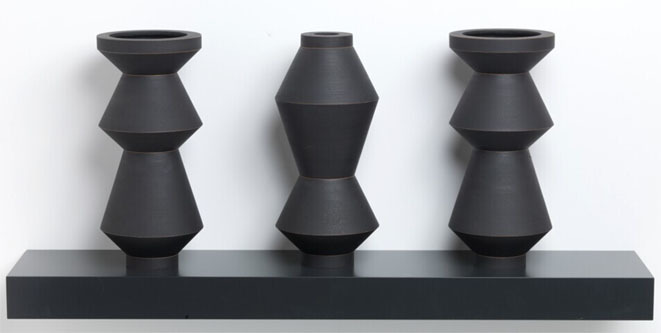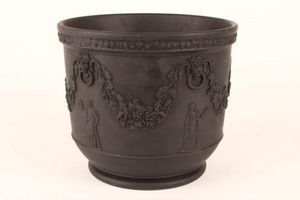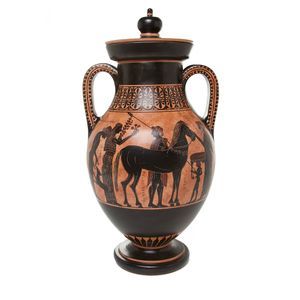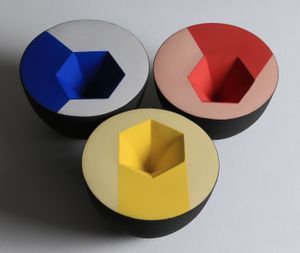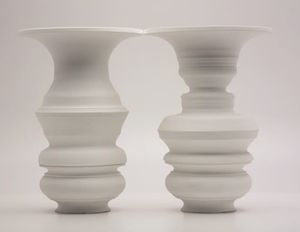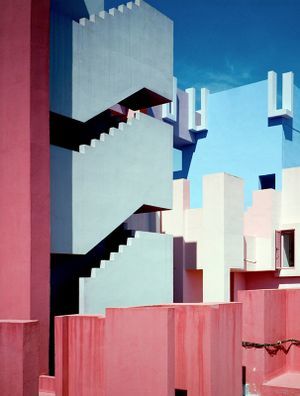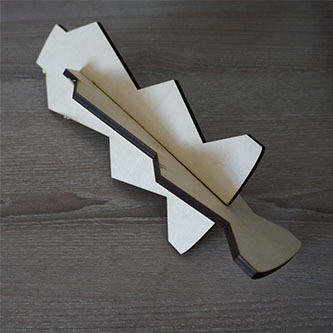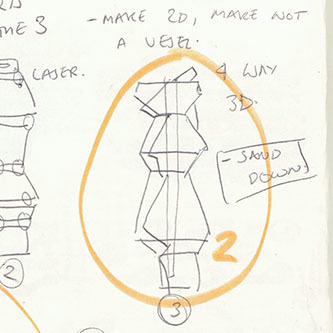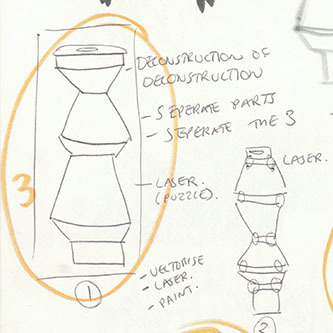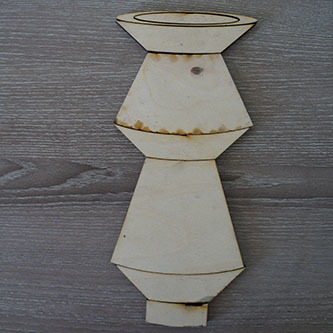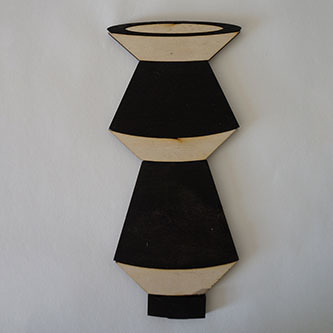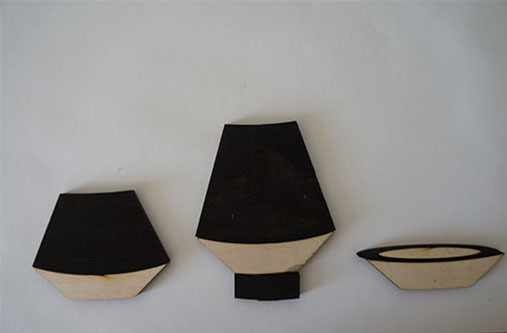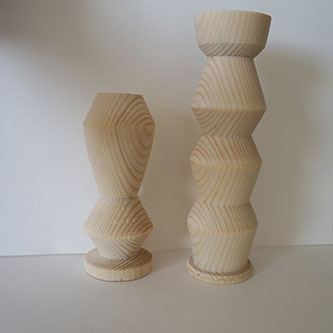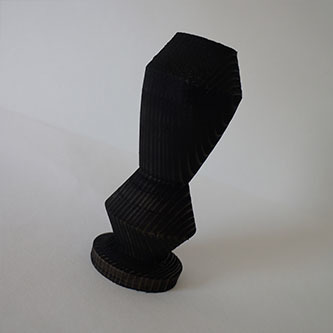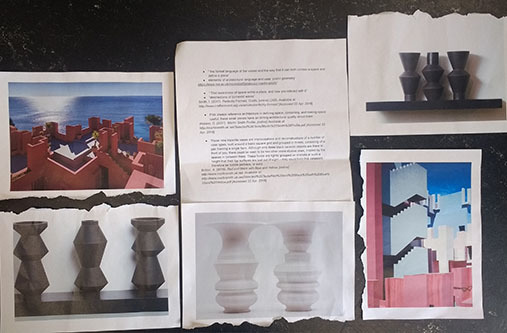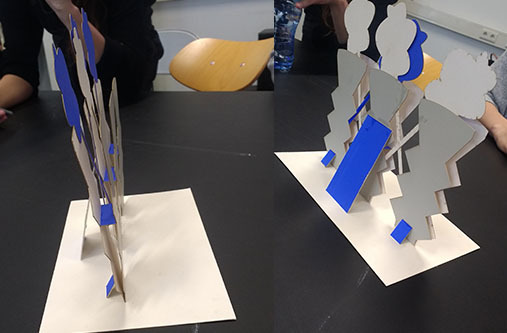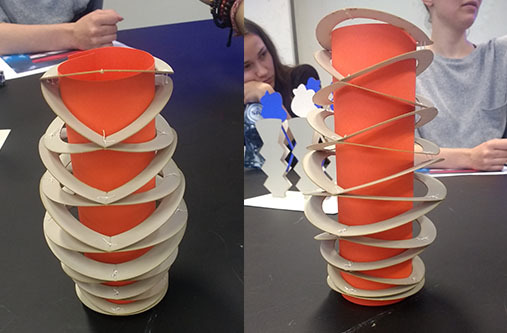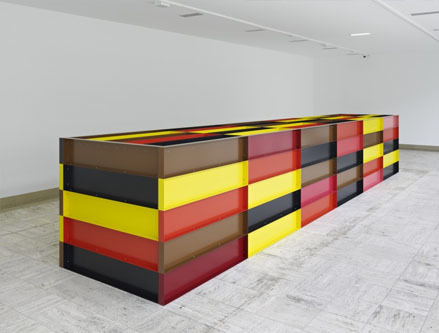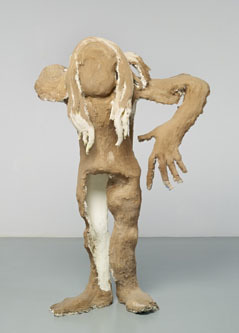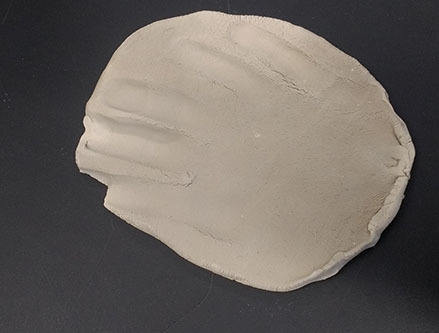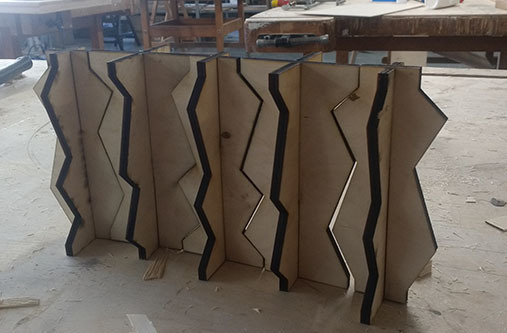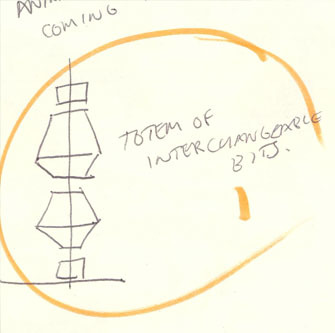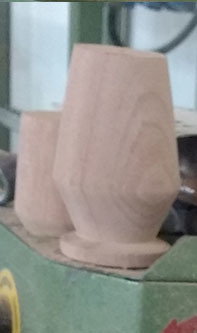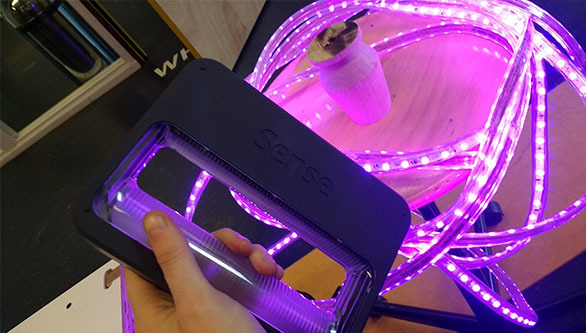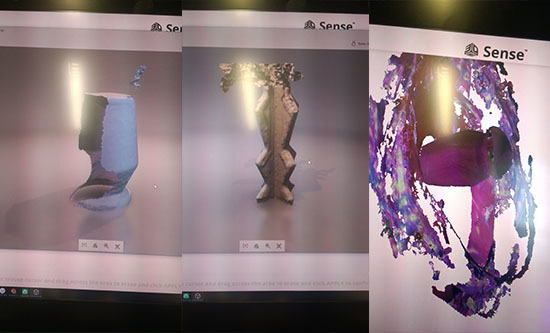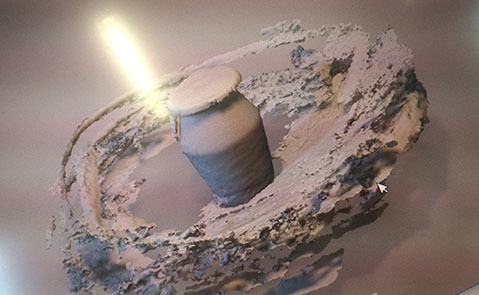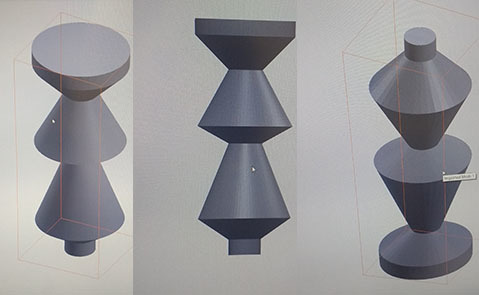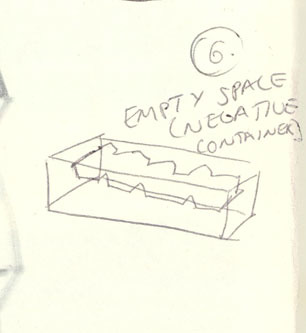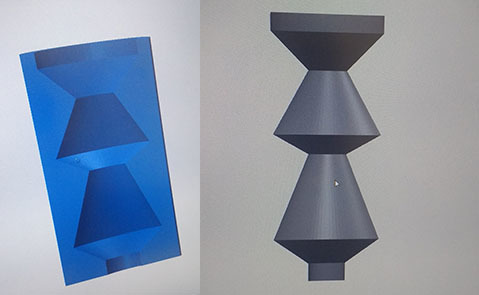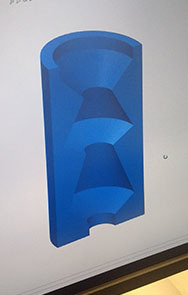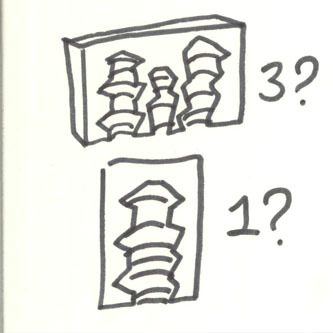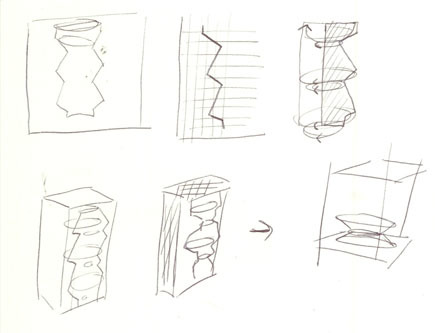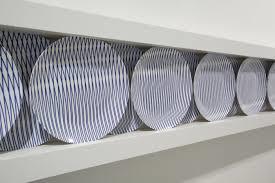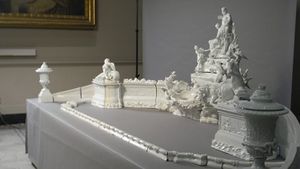Difference between revisions of "User:0960620"
(→WORK) |
|||
| (26 intermediate revisions by the same user not shown) | |||
| Line 1: | Line 1: | ||
| − | + | =='''RESEARCH'''== | |
| − | + | (Martin Smith: "Triptych in the form of Vase no. 1") | |
[[File:Triptych.jpg]] | [[File:Triptych.jpg]] | ||
| Line 34: | Line 34: | ||
The third aspect that interests me is the fact that this work is the fact it is a Triptych. Not merely one form, but three interacting. I think for my experiments, I will mostly focus on one form at a time, so I can invest fully into the decision for the final work if I want to make three. But equally, the three are balance- to change the balance of the piece could make it interesting in itself, a deconstruction of the parts so carefully aligned to make a perfect, geometric Triptych. I think when I make my final I will reflect on whether I want it to resemble and or echo the three-orientated nature of the original, or if there is more meaning to be found in taking apart the Triptych into singular vessels. | The third aspect that interests me is the fact that this work is the fact it is a Triptych. Not merely one form, but three interacting. I think for my experiments, I will mostly focus on one form at a time, so I can invest fully into the decision for the final work if I want to make three. But equally, the three are balance- to change the balance of the piece could make it interesting in itself, a deconstruction of the parts so carefully aligned to make a perfect, geometric Triptych. I think when I make my final I will reflect on whether I want it to resemble and or echo the three-orientated nature of the original, or if there is more meaning to be found in taking apart the Triptych into singular vessels. | ||
| − | ==''' | + | =='''FIRST EXPERIMENTS'''== |
[[File:Alicecc2.jpg]] [[File:Alicecc3.jpg]] | [[File:Alicecc2.jpg]] [[File:Alicecc3.jpg]] | ||
| Line 56: | Line 56: | ||
[[File:Alicecc10.jpg]][[File:Alicecc11.jpg]] | [[File:Alicecc10.jpg]][[File:Alicecc11.jpg]] | ||
| − | I wanted to understand the craft and form of my artefact with hand-crafted methods before I went fully digital. I planned to maybe make a physical version of the artefact in wood and then scan/print it in 3D somehow. Woodturning seemed like a quicker and easier way to appropriate a part of the artefact (the form) and then make it something new (a wooden form). | + | I wanted to understand the craft and form of my artefact with hand-crafted methods before I went fully digital. I planned to maybe make a physical version of the artefact in wood and then scan/print it in 3D somehow. Woodturning seemed like a quicker and easier way to appropriate a part of the artefact (the form) and then make it something new (a wooden form). This was my method designed to "steal" the design from the museum- as it created a beautiful, very similar shape and form to the original. |
| + | |||
| + | =='''PEER GROUP'''== | ||
| + | |||
| + | [[File:Alicecc12.jpg]] | ||
| + | |||
| + | We presented our research to two other people in the class. This was my collection of images/quotes. I received two interpretations of my own work | ||
| + | |||
| + | [[File:Thing2.jpg]] | ||
| + | |||
| + | The first explored the fact I was interested in negative space and the fact they were vases/vessels, so he put objects into them to break their geometric effect and made flowers cross over and fill the negative space. | ||
| + | |||
| + | [[File:Thing3.jpg]] | ||
| + | |||
| + | The second made the vase into a form that was made up almost entirely of negative space- (ignoring the orange part), it was a structure of a vessel that would have never functioned as a vessel. It was a future interpretation of how my artefact could be appropriated and continued, and I found it really interesting because of the way it explored how the structure of a vessel could change over time. | ||
| + | |||
| + | I made two artefacts for my peers, based on their pieces. | ||
| + | |||
| + | [[File:Bigboxman.jpg]] (Donald Judd) | ||
| + | |||
| + | He was interested in the way that the box interacts with the space it is placed in and takes up so much of the room. | ||
| + | |||
| + | [[File:Boxbox.jpg]] (Future) | ||
| + | |||
| + | I laser-cut a net of a box with lots of rectangular holes in it. It made the design easy to replicate (as it could be laser cut), and so the user had to interact with it (to fold, glue and make the box). The holes in the box gave it an interesting interaction with the space around it as you could see the walls through it, it interacted with the space it was in as the space it was in became part of it. | ||
| + | |||
| + | [[File:Brownladybrown.jpg]] (Thomas Houseago) | ||
| + | |||
| + | He was interested in how the woman looked disfigured and misshapen, and was going to focus on freak show attractions, people with too many limbs, and the environment of distorting humans. | ||
| + | |||
| + | [[File:Handhand.jpg]] (Past) | ||
| + | |||
| + | I put an imprint of a 6 fingered hand into clay. I thought it made an interesting artefact, as where the original was a woman, this was an imprint of what she could have left behind. It took the simplicity of something like a footprint, fossil or human remain, and added a narrative that insinuated there was a freak-show anomaly about the person who left the imprint. | ||
| + | |||
| + | [[Did this exercise help me develop my ideas?]] | ||
| + | |||
| + | It was interesting to present my ideas to other people and see how they interpreted my project. It helped to talk through my ideas and inspirations to make it clear in my head what sort of research I wanted to continue. However, it felt like a waste of time when I could have been making for several hours. | ||
| + | |||
| + | =='''REPRODUCTION OF FORM OF MY CHOSEN ARTEFACT'''== | ||
| + | |||
| + | For the next session with John, I created an artefact that developed my own research further. I worked out how to use the laser cutter and made a collection of 5 objects that fitted each other perfectly, based on the shape of the Triptych and the negative space inbetween each vase. It made all shapes 3D, tangible and interchangeable. It further deconstructs the form by making it a series of objects that can link together or be deconstructed themselves. | ||
| + | |||
| + | [[File:Thing1.jpg]] | ||
| + | |||
| + | =='''MORE EXPERIMENTS'''== | ||
| + | |||
| + | [[File:Totemtotem.jpg]] | ||
| + | [[File:Woodturnythingie.jpg]] [[File:Vaseforms.jpg]] | ||
| + | |||
| + | I continued woodturning with a new idea. Turning forms (curved and geometric), then sawing them up into pieces. With a hole in the middle, the idea was that they could be slotted onto a metal pole and the viewer could interact with the work by constructing and deconstructing forms that fitted over each other, in a sort of totem fashion. It's the ultimate appropriation of the idea of deconstructing the ceramic form, because you can physically construct and deconstruct the forms. | ||
| + | |||
| + | However, it was quite difficult to put a hole in the middle as there was no giant, long drill. I had to saw the blocks of wood I began with at 45 degrees, then add a hole, glue it back together, and THEN turn the forms. I'm also quite new to woodturning, so it was impossible to perfectly replicate the forms. The hole, being not perfect, was also not very wide and it was difficult to slot forms on top of each other using the metal pole. I also couldn't sand the bottoms of the forms to a perfect, flat surface, so when stacked they didn't sit quite straight. However, the idea was still an interesting experiment. | ||
| + | |||
| + | I decided to try and explore the idea of form further. Now I'd taken steps to understand the form, I wanted to translate them into something digital. I sought out ways to do this, and discovered 3D scanning. | ||
| + | |||
| + | [[File:Lightlightlight.jpg]] | ||
| + | |||
| + | The lighting in the studio wasn't great for 3D scanning, so I used some lights to try and make the process better. However, this actually made it worse as it added noise to the scan. It was an interesting effect, but not the outcome I wanted to appropriate part of the artefact. | ||
| + | |||
| + | [[File:Lightup3d.jpg]][[File:Lightup3d2.jpg]] | ||
| + | |||
| + | (Some of the outcomes of 3D scanning in parts of the forms I wood-turned) | ||
| + | |||
| + | I thought I might be able to scan in some of the wooden forms, then 3D print the outcomes to make forms that could be stacked on top of each other to make new artefacts. However, with the incomplete nature of the scans (they were only half finished and looked delicate), I decided to try another way. I used the 3D mapping software solidworks to design something resembling the Triptych. | ||
| + | |||
| + | [[File:3dforms.jpg]] | ||
| + | |||
| + | I'd originally had an idea to represent the white space around the forms by encasing them in some form of clay. However, I quickly discovered (by accident) that it was really easy to create a 3D model of the form and a shell in solidworks. | ||
| + | |||
| + | [[File:Negativespace.jpg]][[File:Formandshell.jpg]] | ||
| + | |||
| + | Therefore, my plan for my final artefact appropriating from the original, is to make a white shell, to show the interaction of the forms in the triptych with the negative space. This way, instead of the white space being background, it encompasses the form and becomes the form. It deconstructs the idea of the black forms as ceramic vessels as the only vessel, as the white form becomes a vessel in itself. | ||
| + | |||
| + | [[File:Formshell2.jpg]] | ||
| + | |||
| + | (Imagine the blue is white, and the grey is black) | ||
| + | |||
| + | This is my plan for 3D printing my final shell. | ||
| + | |||
| + | Note: on making it a trio or not | ||
| + | |||
| + | [[File:Threeisacrowd.jpg]] | ||
| + | |||
| + | I experimented with designs for a shell that contained a singular element and a trio, and came to the conclusion that the singular element looked better stylistically, and also functioned best as one singular vessel. It makes more sense to have a white vessel with a specific form than it does to have one that obviously isn't a vessel by itself. | ||
| + | |||
| + | |||
| + | =='''FINAL (CONTEMPORARY TRANSFORMATION)'''== | ||
| + | |||
| + | [[File:VASE3D.jpg]] | ||
| + | |||
| + | This is my final, an appropriation of the form of the object. I decided to transform the negative white space around the artefact into an object in itself, and discovered through using 3D building software (like solidworks) I could make a perfect opposite of the shape of one of the forms from the original Triptych. It appropriates the form of the object, but is the inverse of it. The original triptych was interesting as the matt black forms interacted with the white wall behind them, creating almost 5 forms instead of 3. Through thorough exploration, I've found the most interesting way to appropriate one of the vessels is to make the negative space around the vessel into a vessel itself. I think the outcome is really interesting and is such a simple but eloquent way to make work based on the artefact. | ||
| + | |||
| + | [[File:Blueprintplanvase.jpg]] | ||
| + | |||
| + | (Method of creating this) | ||
| + | |||
| + | =='''A 1000 word statement defining your position of what where your specific 'craft' lies in relation newer technologies'''== | ||
| + | |||
| + | |||
| + | In my project, I appropriated the work of Martin Smith. His work already uses new technologies to make modern, abstract and geometric ceramic forms. However, I took it to another level with my project. I changed the craft and focused on the form. I made it digital, by mapping out a version of one of the forms of his “Triptych in the form of vase no.1” in solidworks, then translating it to a 3D printer file. 3D printing the form made it, again, a crafted thing, a physical thing, a coming together of man and machine to make something technically perfect. | ||
| + | |||
| + | My chosen artefact, “Triptych in the form of Vase no.1” by Martin Smith, is a work of ceramic pottery. Pottery, interestingly, is an example of “technology” in the past being used to create something too perfect to just be made by human hands. A potter’s wheel is kicked or spins, creating unnaturally perfect forms. Pottery as a craft has always been a combination of man and technology. A potter’s wheel is a tool, an ancient but still relevant technology. | ||
| + | |||
| + | Ceramics is a craft as old as humans are. We’ve used it for millenia to make the vessels that keep us alive- plates for eating, pots for storage, vases for decoration... Ceramics are sacred, domestic and mundane, but have been and still are vital to our modern lives. The work of Martin Smith is particularly interesting as he continues research and pushes the way that we can explore ceramics, their applications and meaning, and new technologies that can combine with them. | ||
| + | |||
| + | |||
| + | His bodies of work always combine ceramics and new technologies. In the series “two corners”, the designs run over a series of plates, too perfect to be crafted by humans, obviously digital. This body of work was inspired by graphs, music and the art of Sol LeWitt. It’s a great example of exploiting the potential of something as domestic as a plate and making it a medium on which to explore new technologies and abstract ideas. To create these, he worked in Adobe Illustrator to design the arcs that run across the plates. The drawing was them divided into circular sections, from which he made “digital, on-glaze decals”. | ||
| + | |||
| + | [[File:Martinsmithtwocorners.jpg|thumb|"Two Corners" Martin Smith]] | ||
| + | |||
| + | Ceramics and digital printing combine through digitally printing onto surfaces. Smith headed a project named “Extending the Potential for the digitally printed ceramic surface” and is the current expert for combining ceramics and print. In the UK, the ceramics industry is in a major recession. With new technologies, this research project aimed to: “revitalize the UK ceramics industry and so support regeneration across the UK in locations where ceramics manufacturing is situated.” It also creates new potential for aesthetics and design, as well as “increased speeds, scales and economies of production.”. | ||
| + | |||
| + | The “craft” I have finished my project on- 3D printing & scanning- has a lot of relations to new technologies. An interesting example of the crossover between ceramics and 3D printing is an experiment called “Innovating Ceramics: The Future of Architectural Applications”. It was a research study about robotic fabrication techniques, ran by ASCER Tile of Spain at the Harvard University Graduate School of Design. Clay can be “printed” by a robotic extruder that can be programmed to move in certain ways and patterns to create perfect, ceramic forms. In the future, perhaps ceramic forms could even be 3D printed. | ||
| + | |||
| + | |||
| + | Another example of the crossover of 3D scanning/printing and ceramics is In 2014, a one-of-a-kind, porcelain table fountain made by Meissen was reassembled as a complete object for the first time in 150 years. This was done using 3D scanning/printing to make perfectly fitting replications of the missing parts of the object. Ceramics is an old, painstaking craft. But in order to complete this project, many modern techniques were employed- trials to “rigorously” test the clay mix for colour, “scaling up scans” to allow for shrinkage...and then a return to hand-made methods for the actual moulds themselves, “slabs of clay were rolled and pressed into moulds by hand, with fists and knuckles”. | ||
| + | |||
| + | [[File:Ba7a473dfa7102e48aa0f39747329cde.jpg|thumb|Meissen Fountain]] | ||
| + | |||
| + | |||
| + | Two interesting relations between ceramics and new technologies come up here. First, if something is replicated by ceramic, is it still a craft? Should the viewer of the object be informed that part of the object is restored (should it be coloured/made to stand out from the rest), or should the aim of restoration to be to create a perfect illusion of the original? The other relation is the idea of authenticity: in a new age of digital reproduction, what is authorship? Perhaps it is something of the author’s, but perhaps some authorship can lie too with someone who replicates a work and makes it their own. These are questions we must ask ourselves in the day and age where digital reproduction. | ||
| + | |||
| + | In this frame of mind, is my final outcome an interesting way of looking at ceramics? It takes Martin Smith’s body of work and reduces it even further into a geometric, architectural form. However, it takes away from the craft element of the ceramics away. So much of ceramic craft is about working with clay- working tirelessly against the material to achieve the right glaze, shape and form without shrinkage. By taking the same form, appropriating it, and 3D printing it, it doesn’t achieve the same level of craft. However, it does bridge a gap between ceramics and newer technologies- it takes forms that are typically ceramic, and makes it into something new entirely. | ||
| + | |||
| + | There’s a lot of room for crossover in ceramics and technology, however most new technologies require very specific facilities and equipment to achieve. It’s interesting that even today ceramics is a developing and relevant industry, and things are still changing. There’s a lot of potential for new ways of making and crafting new aesthetics with ceramics with new technology. | ||
| + | |||
| + | Sources: | ||
| + | 1. cfileonline. (2013). Martin Smith Talks About His Plates. [online] Available at: https://cfileonline.org/art-martin-smith-talks-plates/ [Accessed 22 Apr. 2018] | ||
| + | |||
| + | |||
| + | 2. Smith, I. (2017). Perfectly Formed. Crafts, [online] (269). Available at: http://www.craftscouncil.org.uk/articles/perfectly-formed/ [Accessed 22 Apr. 2018. | ||
| + | |||
| + | 3. Extending the Potential for the Digitally Printed Ceramic Surface. (2018). [online] Royal College of Art, School Of Material. Available at: http://gtr.ukri.org/projects?ref=AH%2FM004333%2F1 [Accessed 22 Apr. 2018]. | ||
| + | |||
| + | 4. King, N. (2014). Innovating Ceramics: The Future of Architectural Applications. [video] Available at: https://vimeo.com/93772684 [Accessed 22 Apr. 2018]. | ||
| + | |||
| + | 5. Royal College of Art. (2014). Meissen Fountain Remodelled and Restored by RCA Ceramics & Glass Staff. [online] Available at: https://www.rca.ac.uk/news-and-events/news/meissen-fountain-restored-rca-ceramics-glass-staff/ [Accessed 22 Apr. 2018]. | ||
| + | |||
| + | 6. Watson, O. (2017). Martin Smith Profile. [online] Available at: http://martinsmith.uk.net/Selected%20Texts/Martin%20Smith%20Profile.pdf [Accessed 22 Apr. 2018]. | ||
| + | 7. Clark, G. (2018). Exhibition | Martin Smith: Minimalist Master Levitates Volume at the Marsden Woo Gallery. [online] cfileonline. Available at: https://cfileonline.org/martin-smith-contemporary-ceramic-art/ [Accessed 24 Nov. 2015]. | ||
| − | + | 8. Britton, A. (2015). Red and Black with Blue and Yellow. [online] http://www.martinsmith.uk.net. Available at: http://www.martinsmith.uk.net/Selected%20Texts/Red%20and%20Black%20with%20Blue%20and%20Yellow.pdf [Accessed 22 Apr. 2018] | |
Latest revision as of 20:38, 10 May 2018
Contents
RESEARCH
(Martin Smith: "Triptych in the form of Vase no. 1")
I started off using this artifact as the beginning of my research. I was drawn to it's geometry, symmetry and the way that the matt, black objects interacted with the negative white space inbetween them, to not just make 3 forms but 5.
Further research led me to the fact that the ceramicist, Martin Smith, was heavily intereseted in architecture (hence the perfect geometry of his work) and new technology in ceramics. This particular piece, "Triptych in the form of Vase no. 1", is a deconstruction of the forms of the plate, the bowl and the vase; combining the seperate forms into three conglomerate sculptures, he explores how abstract he can make these parts.
The forms were also inspired by Wedgewood Black, a matt-black ceramic look popularised by the company Wedgewood, and vases from Greek antiquity, distinct in their terracotta with black glaze and their narrative style. These forms tell a new narrative. The hint of terracotta at the seams of the forms reminds the viewer these are not just sculptures, different though they are from the archetypal ceramic object, they are still inspired and grounded in ceramic history. These ideas gave me a lot to work with in terms of the context of my artifact.
My initial research into Martin Smith, his work, and my chosen artefact turned up lots of useful quotes:
- "the formal language of the vessel and the way that it can both contain a space and define a place”
- (Smith uses) "...elements of architectural language and uses ‘poetic geometry’"
- “abstractions of domestic wares”
- "Pots always reference architecture in defining space, containing, and making space useful; these small pieces have an strong architectural quality about them"
- "These new tripartite vases are improvisations and deconstructions of a number of vase types, built around a basic square grid and grouped in threes, consisting of a pair framing a single form. Although only three black ceramic objects are there in front of you, there could be seen to be two other more elusive ones, implied by the spaces in between them. These forms are tightly grouped on shelves at such a height that their top surfaces are just out of sight – they could from this viewpoint therefore be hollow perhaps, or solid."
To present my artefact to my peers, I referenced other pieces of ceramics I found that also referenced geometry and negative space, as examples of how these elements of the design could be explored in different ways.
I also referenced La Muralla Roja, a piece of architecture in Spain that is entirely geometric. The building is pink & blue, and the way these planes of colour and the negative space of the sky interact is interesting.
This preliminary research into my artefact made me the most interested in three aspects of my form. First: negative space. In this Triptych, the white, reflective wall interacts as much with the black forms as much as the forms interact with each other. I think to make a 3D, tangible aspect of the shape of the white space between the forms would be an interesting way to explore the artefact. That, or bringing the white forms to life alongside black forms, so the two could truly interact physically.
The second aspect that interests me about the form is the fact that it is a deconstruction of domestic ceramic vessels- example, the archetypal plate, bowl and vase. I think it would be interesting to create a tangible way of letting the viewer understand this deconstruction. Perhaps by letting the viewer arrange, construct and deconstruct forms themselves from similar shaped geometric pieces to the ones in Smith's work.
The third aspect that interests me is the fact that this work is the fact it is a Triptych. Not merely one form, but three interacting. I think for my experiments, I will mostly focus on one form at a time, so I can invest fully into the decision for the final work if I want to make three. But equally, the three are balance- to change the balance of the piece could make it interesting in itself, a deconstruction of the parts so carefully aligned to make a perfect, geometric Triptych. I think when I make my final I will reflect on whether I want it to resemble and or echo the three-orientated nature of the original, or if there is more meaning to be found in taking apart the Triptych into singular vessels.
FIRST EXPERIMENTS
I started by lasercutting, as it is digital and craft. My aim was to make a 3D sculpture that further reduced the form of this artefact down and dissected it's form. Is a vase still a vase if it exists in 3D but cannot be filled, and exists on a 2D plane? I traced out the outline of the form and vectorised it so it would fit together as a 3D form.
However, the first time I did this, the "craft" side went wrong- the wood didn't fit perfectly. I decided I'd try again with this idea later with other forms, because making a 3D form 2D but still 3D interests me.
I also laser cut a 2D form of one of the vases, with the idea of further deconstructing the vases back into their original form (plate, vase, bowl). I coloured one half into a matt black. The idea was that the viewer could arrange the pieces, forever constructing or deconstructing whichever form they liked, making it a true, limitless deconstruction. I found, also, when I mixed the black/white sides together, it also created an interesting effect and more ways of arranging the pieces.
(Example of how the pieces would be deconstructed to make 2D forms representing different ceramic pieces)
The second aspect of my artefact that I wanted to initially explore was how I would create a ceramic vessel but in another medium.
I wanted to understand the craft and form of my artefact with hand-crafted methods before I went fully digital. I planned to maybe make a physical version of the artefact in wood and then scan/print it in 3D somehow. Woodturning seemed like a quicker and easier way to appropriate a part of the artefact (the form) and then make it something new (a wooden form). This was my method designed to "steal" the design from the museum- as it created a beautiful, very similar shape and form to the original.
PEER GROUP
We presented our research to two other people in the class. This was my collection of images/quotes. I received two interpretations of my own work
The first explored the fact I was interested in negative space and the fact they were vases/vessels, so he put objects into them to break their geometric effect and made flowers cross over and fill the negative space.
The second made the vase into a form that was made up almost entirely of negative space- (ignoring the orange part), it was a structure of a vessel that would have never functioned as a vessel. It was a future interpretation of how my artefact could be appropriated and continued, and I found it really interesting because of the way it explored how the structure of a vessel could change over time.
I made two artefacts for my peers, based on their pieces.
He was interested in the way that the box interacts with the space it is placed in and takes up so much of the room.
I laser-cut a net of a box with lots of rectangular holes in it. It made the design easy to replicate (as it could be laser cut), and so the user had to interact with it (to fold, glue and make the box). The holes in the box gave it an interesting interaction with the space around it as you could see the walls through it, it interacted with the space it was in as the space it was in became part of it.
He was interested in how the woman looked disfigured and misshapen, and was going to focus on freak show attractions, people with too many limbs, and the environment of distorting humans.
I put an imprint of a 6 fingered hand into clay. I thought it made an interesting artefact, as where the original was a woman, this was an imprint of what she could have left behind. It took the simplicity of something like a footprint, fossil or human remain, and added a narrative that insinuated there was a freak-show anomaly about the person who left the imprint.
Did this exercise help me develop my ideas?
It was interesting to present my ideas to other people and see how they interpreted my project. It helped to talk through my ideas and inspirations to make it clear in my head what sort of research I wanted to continue. However, it felt like a waste of time when I could have been making for several hours.
REPRODUCTION OF FORM OF MY CHOSEN ARTEFACT
For the next session with John, I created an artefact that developed my own research further. I worked out how to use the laser cutter and made a collection of 5 objects that fitted each other perfectly, based on the shape of the Triptych and the negative space inbetween each vase. It made all shapes 3D, tangible and interchangeable. It further deconstructs the form by making it a series of objects that can link together or be deconstructed themselves.
MORE EXPERIMENTS
I continued woodturning with a new idea. Turning forms (curved and geometric), then sawing them up into pieces. With a hole in the middle, the idea was that they could be slotted onto a metal pole and the viewer could interact with the work by constructing and deconstructing forms that fitted over each other, in a sort of totem fashion. It's the ultimate appropriation of the idea of deconstructing the ceramic form, because you can physically construct and deconstruct the forms.
However, it was quite difficult to put a hole in the middle as there was no giant, long drill. I had to saw the blocks of wood I began with at 45 degrees, then add a hole, glue it back together, and THEN turn the forms. I'm also quite new to woodturning, so it was impossible to perfectly replicate the forms. The hole, being not perfect, was also not very wide and it was difficult to slot forms on top of each other using the metal pole. I also couldn't sand the bottoms of the forms to a perfect, flat surface, so when stacked they didn't sit quite straight. However, the idea was still an interesting experiment.
I decided to try and explore the idea of form further. Now I'd taken steps to understand the form, I wanted to translate them into something digital. I sought out ways to do this, and discovered 3D scanning.
The lighting in the studio wasn't great for 3D scanning, so I used some lights to try and make the process better. However, this actually made it worse as it added noise to the scan. It was an interesting effect, but not the outcome I wanted to appropriate part of the artefact.
(Some of the outcomes of 3D scanning in parts of the forms I wood-turned)
I thought I might be able to scan in some of the wooden forms, then 3D print the outcomes to make forms that could be stacked on top of each other to make new artefacts. However, with the incomplete nature of the scans (they were only half finished and looked delicate), I decided to try another way. I used the 3D mapping software solidworks to design something resembling the Triptych.
I'd originally had an idea to represent the white space around the forms by encasing them in some form of clay. However, I quickly discovered (by accident) that it was really easy to create a 3D model of the form and a shell in solidworks.
Therefore, my plan for my final artefact appropriating from the original, is to make a white shell, to show the interaction of the forms in the triptych with the negative space. This way, instead of the white space being background, it encompasses the form and becomes the form. It deconstructs the idea of the black forms as ceramic vessels as the only vessel, as the white form becomes a vessel in itself.
(Imagine the blue is white, and the grey is black)
This is my plan for 3D printing my final shell.
Note: on making it a trio or not
I experimented with designs for a shell that contained a singular element and a trio, and came to the conclusion that the singular element looked better stylistically, and also functioned best as one singular vessel. It makes more sense to have a white vessel with a specific form than it does to have one that obviously isn't a vessel by itself.
FINAL (CONTEMPORARY TRANSFORMATION)
This is my final, an appropriation of the form of the object. I decided to transform the negative white space around the artefact into an object in itself, and discovered through using 3D building software (like solidworks) I could make a perfect opposite of the shape of one of the forms from the original Triptych. It appropriates the form of the object, but is the inverse of it. The original triptych was interesting as the matt black forms interacted with the white wall behind them, creating almost 5 forms instead of 3. Through thorough exploration, I've found the most interesting way to appropriate one of the vessels is to make the negative space around the vessel into a vessel itself. I think the outcome is really interesting and is such a simple but eloquent way to make work based on the artefact.
(Method of creating this)
A 1000 word statement defining your position of what where your specific 'craft' lies in relation newer technologies
In my project, I appropriated the work of Martin Smith. His work already uses new technologies to make modern, abstract and geometric ceramic forms. However, I took it to another level with my project. I changed the craft and focused on the form. I made it digital, by mapping out a version of one of the forms of his “Triptych in the form of vase no.1” in solidworks, then translating it to a 3D printer file. 3D printing the form made it, again, a crafted thing, a physical thing, a coming together of man and machine to make something technically perfect.
My chosen artefact, “Triptych in the form of Vase no.1” by Martin Smith, is a work of ceramic pottery. Pottery, interestingly, is an example of “technology” in the past being used to create something too perfect to just be made by human hands. A potter’s wheel is kicked or spins, creating unnaturally perfect forms. Pottery as a craft has always been a combination of man and technology. A potter’s wheel is a tool, an ancient but still relevant technology.
Ceramics is a craft as old as humans are. We’ve used it for millenia to make the vessels that keep us alive- plates for eating, pots for storage, vases for decoration... Ceramics are sacred, domestic and mundane, but have been and still are vital to our modern lives. The work of Martin Smith is particularly interesting as he continues research and pushes the way that we can explore ceramics, their applications and meaning, and new technologies that can combine with them.
His bodies of work always combine ceramics and new technologies. In the series “two corners”, the designs run over a series of plates, too perfect to be crafted by humans, obviously digital. This body of work was inspired by graphs, music and the art of Sol LeWitt. It’s a great example of exploiting the potential of something as domestic as a plate and making it a medium on which to explore new technologies and abstract ideas. To create these, he worked in Adobe Illustrator to design the arcs that run across the plates. The drawing was them divided into circular sections, from which he made “digital, on-glaze decals”.
Ceramics and digital printing combine through digitally printing onto surfaces. Smith headed a project named “Extending the Potential for the digitally printed ceramic surface” and is the current expert for combining ceramics and print. In the UK, the ceramics industry is in a major recession. With new technologies, this research project aimed to: “revitalize the UK ceramics industry and so support regeneration across the UK in locations where ceramics manufacturing is situated.” It also creates new potential for aesthetics and design, as well as “increased speeds, scales and economies of production.”.
The “craft” I have finished my project on- 3D printing & scanning- has a lot of relations to new technologies. An interesting example of the crossover between ceramics and 3D printing is an experiment called “Innovating Ceramics: The Future of Architectural Applications”. It was a research study about robotic fabrication techniques, ran by ASCER Tile of Spain at the Harvard University Graduate School of Design. Clay can be “printed” by a robotic extruder that can be programmed to move in certain ways and patterns to create perfect, ceramic forms. In the future, perhaps ceramic forms could even be 3D printed.
Another example of the crossover of 3D scanning/printing and ceramics is In 2014, a one-of-a-kind, porcelain table fountain made by Meissen was reassembled as a complete object for the first time in 150 years. This was done using 3D scanning/printing to make perfectly fitting replications of the missing parts of the object. Ceramics is an old, painstaking craft. But in order to complete this project, many modern techniques were employed- trials to “rigorously” test the clay mix for colour, “scaling up scans” to allow for shrinkage...and then a return to hand-made methods for the actual moulds themselves, “slabs of clay were rolled and pressed into moulds by hand, with fists and knuckles”.
Two interesting relations between ceramics and new technologies come up here. First, if something is replicated by ceramic, is it still a craft? Should the viewer of the object be informed that part of the object is restored (should it be coloured/made to stand out from the rest), or should the aim of restoration to be to create a perfect illusion of the original? The other relation is the idea of authenticity: in a new age of digital reproduction, what is authorship? Perhaps it is something of the author’s, but perhaps some authorship can lie too with someone who replicates a work and makes it their own. These are questions we must ask ourselves in the day and age where digital reproduction.
In this frame of mind, is my final outcome an interesting way of looking at ceramics? It takes Martin Smith’s body of work and reduces it even further into a geometric, architectural form. However, it takes away from the craft element of the ceramics away. So much of ceramic craft is about working with clay- working tirelessly against the material to achieve the right glaze, shape and form without shrinkage. By taking the same form, appropriating it, and 3D printing it, it doesn’t achieve the same level of craft. However, it does bridge a gap between ceramics and newer technologies- it takes forms that are typically ceramic, and makes it into something new entirely.
There’s a lot of room for crossover in ceramics and technology, however most new technologies require very specific facilities and equipment to achieve. It’s interesting that even today ceramics is a developing and relevant industry, and things are still changing. There’s a lot of potential for new ways of making and crafting new aesthetics with ceramics with new technology.
Sources: 1. cfileonline. (2013). Martin Smith Talks About His Plates. [online] Available at: https://cfileonline.org/art-martin-smith-talks-plates/ [Accessed 22 Apr. 2018]
2. Smith, I. (2017). Perfectly Formed. Crafts, [online] (269). Available at: http://www.craftscouncil.org.uk/articles/perfectly-formed/ [Accessed 22 Apr. 2018.
3. Extending the Potential for the Digitally Printed Ceramic Surface. (2018). [online] Royal College of Art, School Of Material. Available at: http://gtr.ukri.org/projects?ref=AH%2FM004333%2F1 [Accessed 22 Apr. 2018].
4. King, N. (2014). Innovating Ceramics: The Future of Architectural Applications. [video] Available at: https://vimeo.com/93772684 [Accessed 22 Apr. 2018].
5. Royal College of Art. (2014). Meissen Fountain Remodelled and Restored by RCA Ceramics & Glass Staff. [online] Available at: https://www.rca.ac.uk/news-and-events/news/meissen-fountain-restored-rca-ceramics-glass-staff/ [Accessed 22 Apr. 2018].
6. Watson, O. (2017). Martin Smith Profile. [online] Available at: http://martinsmith.uk.net/Selected%20Texts/Martin%20Smith%20Profile.pdf [Accessed 22 Apr. 2018].
7. Clark, G. (2018). Exhibition | Martin Smith: Minimalist Master Levitates Volume at the Marsden Woo Gallery. [online] cfileonline. Available at: https://cfileonline.org/martin-smith-contemporary-ceramic-art/ [Accessed 24 Nov. 2015].
8. Britton, A. (2015). Red and Black with Blue and Yellow. [online] http://www.martinsmith.uk.net. Available at: http://www.martinsmith.uk.net/Selected%20Texts/Red%20and%20Black%20with%20Blue%20and%20Yellow.pdf [Accessed 22 Apr. 2018]
